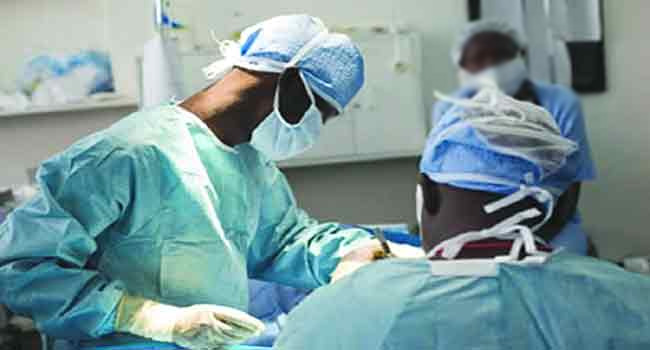It’ll Take Nigeria 20 Years To Produce Enough Health Workers – Stakeholders


- Yusuf Oketola
Leading experts in Nigeria’s health sector have said it would be impossible to produce sufficient personnel to effectively meet the country’s increasing healthcare needs with the current burden of brain drain.
They held that it would take Nigeria 20 years, at the minimum, to produce 400,000 health workers needed to fill in the gap and cater to the health needs of Nigeria’s 220 million population.


The senior medical professionals, while speaking with Journalists, said Nigeria has a horrible ratio of one doctor to 8,000 patients, which is against the World Health Organisation recommendation of one doctor to 600 patients.
The Coordinating Minister of Health and Social Welfare, Professor Ali Pate, not long ago, said the country still needs about 400,000 health workers to cater to the healthcare needs of Nigerians effectively.
Addressing newsmen in Abuja, after his three-day briefing session with departments and agencies under the ministry, Pate said, “The 400,000 workforce comprise community health workers, nurses, midwives, pharmacists, physicians, lab scientists, technicians, and auxiliaries working in the Nigerian healthcare system.”
The minister explained that the health workers are not enough as the number cannot take care of 220 million people, stressing that the doctor-to-population ratio in the country is lower than what was specified by the WHO.
He noted that there was still room to produce more and excess because globally, there’s a shortage of health manpower, saying that there is almost a shortage of 18 million people.
According to the Register of the General Medical Council of the United Kingdom, the number of Nigerian-trained doctors practising in the United Kingdom has climbed to 11,001.
READ: Don’t Abandon Inherited Project Like Previous Govt, Adeleke Tells Cabinet
The GMC is a public body that maintains the official register of medical practitioners within the UK.
According to the past President of the Nigerian Medical Association, Professor Mike Ogirima, said the massive migration of Nigerian health workers to foreign countries, mostly in search of greener pastures, has taken its toll on the few doctors left in the system.
He described the doctor-to-patient ratio in Nigeria as horrible.
Ogirima, who is also the Provost, College of Health Sciences, Federal University Lokoja, Kogi State, said for now, the country only produces an average of 3000 doctors annually, lamenting that Nigeria was faced with a huge doctors deficit.
He said, “If we are producing 3000 annually, the gap for doctors is about 280,000. So we need about 10 years to catch up at the rate with which we are producing doctors. If we now add other health workers, we need to double that rate.
“The gap of doctors we need in this country with our population is up to 300,000 now. We need about 10 years to catch up and we can’t wait for 10 years to catch up.
“Currently, Nigeria has a doctor-to-population ratio of one doctor to 8,000 population, instead of one doctor to 600 people as recommended by the WHO. That is why when you go to the hospital, the doctors you meet there are tired.”
The Professor of Orthopaedics and Trauma Surgery said the shortage of medical personnel in Nigerian public hospitals didn’t suddenly happen.
“We currently have about 45,000 doctors practising in Nigeria. Many of them have left the country. If it takes 10 years to get that number of doctors, it will take another 10 years to produce other health workers.
“So, it will take us nothing less than 15 to 20 years to produce 400,000 health workers. If we are deficient and we need 10 years to catch up, know the world will not wait for you and the population is not waiting for you.”
Ogirima, in 2016, said no fewer than 20,000 Nigerian doctors were practising in America and about 15,000 in European countries.
In 2017, the chairman of the Lagos branch of the NMA, Dr. Olumuyiwa Odusote, revealed that about 40,000 of the 75,000 registered medical doctors in Nigeria were practising outside the country, with a rather disturbing caveat that 75 per cent of those still in Nigeria were planning to leave.
Ogrima urged the government to invest in health workers’ training and address the challenges of insecurity, stating that it would be difficult for Nigeria to retain its health workers when the equipment and motivation are not there.
Meanwhile, the Chief Medical Director of Lagos State University Teaching Hospital, Ikeja, Professor Adetokunbo Fabamwo, on his part, said the federal government should try its best to retain the remaining medical doctors in the country.
He said, “What I know is that there is a huge leakage in developing world countries. So health workers are moving en masse from Nigeria to the UK, Canada and the US. I do not know the strategy of the FG to produce 400,000 health workers.
“But I know where to start is to at least keep the ones that we have. The reality on the ground now is that as we are producing, they are leaving. It is like putting water in a basket. If we can block the migration, then we can now start projecting.”
A past President of the Pharmaceutical Society of Nigeria, Olumide Akintayo, told our correspondent that it would be difficult for Nigeria to produce N400,000 health workers due to lack of human resources.
“We cannot produce these numbers in the universities. Who are the people going to train this number,” he asked.
He advised the coordinating minister of health to open restricted borders in healthcare and encourage teamwork among health workers
The mass exodus of healthcare professionals, especially doctors, pharmacists, and nurses has been a burning issue in the country.
A 2017 survey by the Nigerian Polling organisation in partnership with Nigeria Health Watch revealed that about 88 per cent of medical doctors in Nigeria were seeking work opportunities abroad at the time.


Yusuf Oketola is a trained journalist with over five years of experience in the media industry. He has worked for both print and online medium. He is a thorough-bred professional with an eye of hindsight on issues bothering on social justice, purposeful leadership, and a society where the leaders charge and work for the prosperity of the people.










